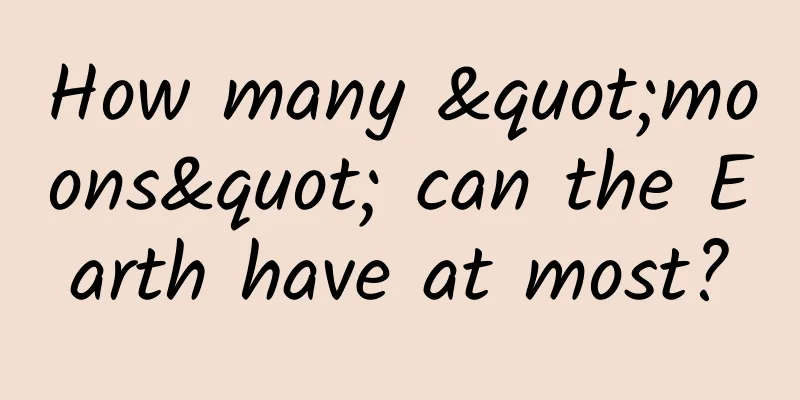How many "moons" can the Earth have at most?

|
The Earth is the only celestial body in the known universe with life, and the Moon is the Earth's only natural satellite. According to astronomers' observations, the Earth has one natural satellite, Mars has two, Mercury and Venus have none, while some other giant planets in the solar system, such as Jupiter and Saturn, have dozens of natural satellites. Think about it: How many "moons" can the Earth have at most? In other words, how many natural satellites the size of the "moon" can a planet like the Earth have at most? In response to the above question, a new study conducted by three physicists gave the answer: 3-7. The specific number depends on the mass of the natural satellite. Figure | Schematic diagram of three "moon" mass satellites orbiting the Earth. The sizes of planets and satellites are calculated to scale, and the satellites are constrained between stability boundaries. The related research paper, titled "Moon-packing around an Earth-mass planet," has been published on the preprint website arXiv. Suman Satyal, an adjunct assistant professor at the University of Texas at Arlington (UTA), is the first author of the paper. "Most planets in the solar system have multiple moons," Satyal said. "Notably, giant planets like Jupiter and Saturn have around 80 moons. But among the rocky planets, Mars has two moons and Earth has one. These differences may be related to different formation mechanisms and orbital evolution processes." In this work, the research team used a series of N-body simulations (approximate particle motion) to try to quantify how many satellites Earth or an exoplanet of comparable mass could have in its orbit. The research team set the N-body simulation of multiple satellites between the inner (Roche radius) and outer (Hill radius) stability limits of the orbital body. Theoretically, if a satellite orbits within the Roche radius, it will be broken apart by the tidal forces of the host planet; if it orbits outside the Hill radius, it will escape the gravitational field of the host planet. "Numerical studies, however, showed that the actual stability limit is within two times the Roche radius, which is about half the Hill radius," Satyal said. "We therefore started simulating multiple satellites (up to nine) between these reduced bounds and checked how many of them would 'survive' to the end of the simulation time." Photo: Suman Satyal, Marialis Rosario-Franco and Billy Quarles. The research team used satellites with the same mass as Ceres, Pluto, and the Moon as prototype masses to calculate orbital stability constraints. They found that three Moon-mass satellites, four Pluto-mass satellites, and seven Ceres-mass satellites could orbit an Earth-mass exoplanet. "Our model ignores the gravitational effects of all the other planets in our solar system," said Billy Quarles, an assistant professor of astronomy and physics at Valdosta State University and one of the paper's authors. "This is important when looking beyond our solar system because there are many systems with only one candidate planet. There are currently two exomoon candidates, but they both orbit Jupiter-like planets at a distance of one astronomical unit (about 150 million kilometers or 93 million miles). Although there are approximately 5,000 known exoplanets that could potentially host dozens of exomoons, no confirmed exomoons have been found to date. Satyal believes there are other constraints and limitations to this lack of detection. Satyal believes that their findings have important implications for future cosmic observations, "because it constrains the presence of Earth-like satellites in their respective habitable zones." Also, as telescopes become more sensitive, such as the recently launched James Webb Space Telescope (JWST), we may be able to apply the transit method (measuring the depth of starlight) to detect exomoons. Since rocky planets like Earth could potentially have more than one moon, this increases the likelihood that they will be discovered. In addition, as the search for exoplanets around Earth-like planets continues, this research may provide an upper limit for scientists to predict how many satellites a planet may have. Additionally, this research may have cultural implications for depictions of exoplanets in science fiction films and other media. "When we were conducting our survey, I watched Stargate and noticed that the exoplanet in our galaxy that the team was traveling to had three moons. "Many movies have illustrated the possibility of exoplanets, such as Pandora in Avatar and the forest moon Endor in Star Wars. Our research can help future work be more astronomically accurate," Quarles said. Reference Links: https://arxiv.org/abs/2208.03604 |
<<: Today’s little-known fact: Japanese tofu is even worse than eggs!!!
>>: Crazy! What should astronauts do if they suddenly have to pee while on the moon?
Recommend
App Annie: Total app store downloads are expected to reach 130 billion in 2020
According to the year-end forecast of mobile data...
Beijing CDC issues health tips for New Year's Day and Spring Festival: encourage people to avoid peak travel times, return home, return to work, and return to school during the Spring Festival travel rush
At present, the epidemic is spreading abroad, and...
How to use the 400 number?
At present, most of the domestic enterprises have...
Taobao virtual no-source e-commerce online course 4 video_Turtle Course
A year's plan begins with spring. You have re...
Google releases 2015 annual search rankings
Following Bing and Baidu, today Google also relea...
Jinlong 2022 Douyin live streaming sales account operation Qianchuan course, only with strategy can there be high investment and production delivery course
Jinlong 2022 Douyin live streaming sales account ...
After three years of rapid development, Jitu is slowing down
The "barbarian" Jitu has learned how to...
Can eating only meat make you healthier? The pros and cons of the Paleo diet
The Paleo diet has become popular in recent years...
Can live streaming really save the offline crisis?
Recently, due to the impact of the epidemic, most...
4 reasons why Microsoft Surface is doomed
The technology website Computerworld recently rep...
How can ordinary people use quantum computers?
How can ordinary people get in touch with real qu...
Uber is having trouble retaining talent, with new head of its AI lab Gary Marcus leaving
According to foreign media reports, Gary Marcus, ...
When launching financial management products, why shouldn’t we worry about short-term channel costs?
As a preliminary note, with the listing of Intern...
Alzheimer's disease may be related to sleep? Scientists have found the key...
Reviewer of this article: Chen Haixu, Deputy Dire...
How to create tourism advertising in information flow during the Qingming and May Day holidays?
When the targeting conditions are almost the same...









